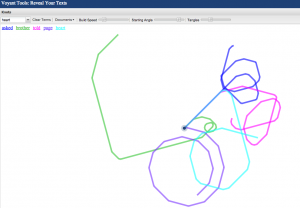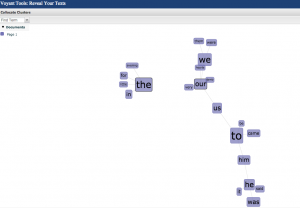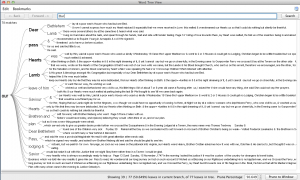
The picture to the left may look like a children’s drawing to most people, but in reality it is an analysis of the frequency of five different words in a document. Every time the word shows up in the document, the assigned, colored line takes a turn at a specified angle. This is a clever visualization, which Digital Humanists use for something called distant reading.
Distant reading is a useful tool for analyzing text from far away. Instead of closely reading every word of a specific document word for word, we can use tools like online applications or programs to analyze the types of words used inside of the document.

These tools provide overall summaries of data like the frequency of words, popularity of words, or relationships (as seen in the image to the right) between words in a certain document. The image to the right is also an example of spatial reading, which means the spaces between the words are there for a reason to do with their relationships with each other.
Recently, we transcribed a Moravian travel journal written by Jasper Payne in 1747. By closely reading this document we learned about the everyday life Payne and his “brethren” lived on their journey, including the places and people they saw and met. A distant reading of this journal may reveal similar aspects of the writings, but it also unveils broader ideas. For example, the following image shows us many interesting things about the writing that we may not have realized in the close reading (click on image to read more clearly):

This “tree map” shows the words that follow the word “our” in the travel journal listed from most common to least common. As you can see, Jasper Payne displayed a lot of emotional religious views in his writing. From this distant reading we can really see exactly how loving and faithful Payne and the Moravian group of people actually were.
Leave a Reply